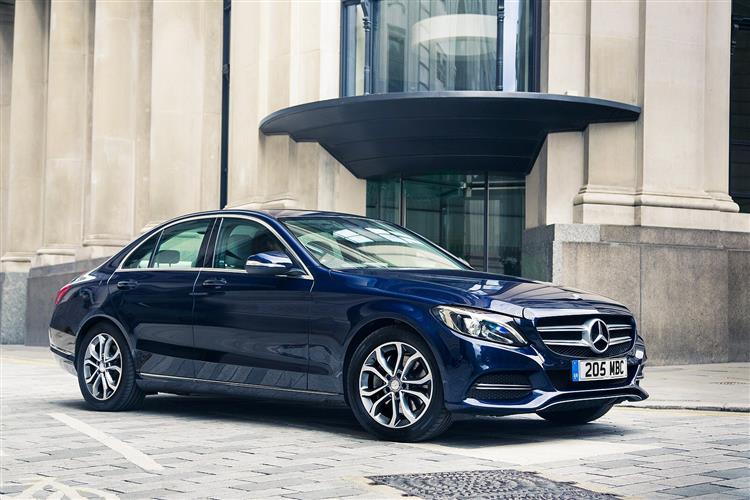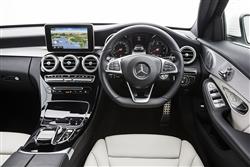C-CHANGE (some text hidden) --NONE--
By Jonathan Crouch
Introductionword count: 78
From its launch in 2014, the fourth generation 'W205'-series C-Class set out to really democratise Mercedes luxury for a wider audience, being lighter, cleverer, nicer to ride in and beautifully finished. Pricing continues to reflects its premium positioning but in this guise more than ever, this more efficient, more desirable design has a look and feel worth every penny. A cut above its BMW 3 Series and Audi A4 rivals? Many will think so on the used market.
Modelsword count: 21
4dr saloon / 5dr estate (1.6 diesel, 2.1 diesel / 1.6 petrol, 2.0 petrol, 3.0 V6 petrol / 4.0 V8 petrol)
Historyword count: 385
The Mercedes C-Class has traditionally campaigned in offering all that its brand knows about luxury saloons distilled into smaller form and in its first two decades of life, over 8.5 million global buyers happily bought into the concept. For all that though, this was in truth for too many years a car a little short on quality and a little long on price tag. It may have been good enough to account for 20% of total Mercedes sales but that wasn't enough to prevent it still always lagging a distant third in the compact executive sector sales charts behind its arch-rivals, BMW's 3 Series and Audi's A4. In 2014 though, we got a very different C-Class, this fourth generation version designed to change the status quo in this segment and redefine what a car of this kind should be. That was a big ask, but there was a greater level of focus with this 'W205' model series C-Class than with any of its predecessors. These were often trying to be too many things to too many people. If you bought one, it was usually for a 'quality feel' rather than because it was the best contender in its segment to drive, the nicest to sit in or the cheapest to run. With this MK4 design though, things changed. In the 2014-2018 period we're looking at here, it was to this C-Class that aspiring middle management executives turned first in their search for something different from - and possibly a bit nicer than - their usual 3 Series or Audi A4 choices. There was certainly more than enough reason for them to seriously consider this car in its fourth generation form. It was slightly bigger and a lot more advanced than the previous model and boasted the nicest cabin you could have in this kind of model. But more important than all of that was the way that this 'W205'-series model's advanced hybrid aluminium structure brought the significant weight savings which made possible some of the lowest running costs in the segment. This then, was the C-Class that BMW and Audi always feared Mercedes would build. It sold until 2018 when it was heavily facelifted, but it's the earlier version which sold between 2014 and 2018 that we look at here as a potential used buy.
What You Getword count: 1313
You don't really have to know very much about cars to recognise a MK4 C-Class. And if you know the Mercedes model range beyond this car, it's probably fairly obvious where the inspiration for this fourth generation design came from. By and large, customers come to this model seeking a scaled-down version of the brand's S-Class luxury limo and with this 'W205'-series design, the long bonnet, the set-back passenger compartment and the short overhangs are just a few of the things delivering exactly that. The result might not please those who've just spent their lottery winnings on a top S-Class model but buyers browsing in this car's less exalted market segment will surely see it as a very desirable-looking thing indeed. Wander round the shapely silhouette and you quickly appreciate the painstaking attention to detail that's gone into things like the wafer-thin shut lines and the intricately formed jewel-like headlamps with their optional LED illumination. There's real classic elegance here too, centred in profile around a waist-level character line - what Mercedes rather awkwardly calls a 'Dropping Line' - that descends discreetly from the front to a rear section where a pronounced shoulder above the back wheel gives the rear end of the car a power-packed look that's emphasised by softly sculptured LED rear tail lights. More important than all of this though, is of course what sits beneath the shapely bodywork - specifically a structure with an aluminium content which with this MK4 model rose massively, from 10% to nearly 50%, resulting in an overall weight-saving of more than 100kg. One of Mercedes' original marketing slogans for this car was that it sat 'one class higher' and that's true not only in terms of style but, arguably, also in terms of size. Almost everything with this 'W205'-series design is, after all, a little larger than it was before. Partly that's because back in 2014, the brand's introduction of their only slightly smaller CLA-Class four-door coupe model gave this 'C' licence to grow a little within the bounds of what was possible before it intruded into Executive-sized E-Class territory - something the designers only just avoided. Even as it was, this car's extra 95mm of length and extra 40mm of width made it as spacious inside as E-Class model from the late Nineties. That's something most obvious from a seat in the rear. True, the sweeping roofline you duck around as you get in suggests that headroom will be at something of a premium for taller folk - and indeed it is once you get yourself inside. Otherwise though, genuine improvements really were made here in terms of rear seat spaciousness in comparison to the previous model. Where before, it wasn't really possible for one six footer to sit behind another in real comfort, the extra 80mm this fourth generation model boasts in its wheelbase length changes that. It's not even quite such a squash to take three folk on short trips, should the need arise. But it's the up-front experience that really sets this fourth generation C-Class apart, not only from its predecessor but also from its immediate period rivals. This, more than anything else, is the thing that will sell this car. Come to the wheel familiar with the old pre-2014 MK3 C-Class model (which had a functional cabin that was about as stylish as Angela Merkel) and you'll find this car radically different, with a broad eye-catching centre console sweeping between the front seats. It's a one-piece design on automatic models, but go for a rarer manual gearbox variant and you'll get the steeper dash with separate trim elements that's necessary for ergonomic operation of the shift lever. Either way, one thing's for certain: you'd have to get a really plush rival BMW 3 Series or Audi A4 for it to feel anything like as nice inside as a C-Class. There are none of the cheap plastics that on those cars, you can find hidden in the lower reaches of the fascia if you look hard enough and this Mercedes, the quality touches - things like the high gloss black trim on the centre console and the Artico man-made leather on the instrument panel - deliver much of the feeling of class upgrade that the brochures promised. Original buyers had the option of beautifully veneered wood and even a lovely analogue clock if they wanted it. Proper luxury then: just distilled into a slightly more compact form. Not that the practicalities were forgotten. There's much more room to stow stuff around the cabin than there was on the previous MK3 model for example: take the door bins - nearly four times larger than before. And, with these sorts of cars, we rarely feel that enough time has been spent on perfecting the seats, given the many hours owners will be stuck in them. The front chairs on a 'W205'-series C-Class though, feel genuinely more comfortable than anything else in the segment from this period can provide, with extra shoulder support and another 10mm of height adjustment over what was delivered before. As you'd expect, the driver's seat positions you beautifully in front of the leather-trimmed three-spoke steering wheel with its 12 multi-function keys. Behind it, there's the brand's usual 'Direct Select' gearchange stalk for automatic models and a smartly efficient pair of 'tube design' round dials separated by a 5.5-inch TFT colour display, the combination of which is a model of clarity. One other nice touch you might not notice: there are no stereo speakers in the doors. Instead, using what Mercedes calls its 'Frontbass' system, they're mounted in the foot wells, installed in cavities that act as resonance chambers and give you clearer, crisper sound. Look around you and the two staples of modern Mercedes cabin style are present and correct. There are five round SLS supercar-style air vents with metallic cool-touch finishing and above the three in the centre sits a prominent iPad-style infotainment screen, its free-standing positioning smacking either of after-thought or inspired design, depending on your point of view. It's 7-inches in size as standard and acts as the display for the rather old-fashioned graphics of the Garmin sat nav system that most original customers specified. Try though, and find a car whose original owner opted for something a bit more sophisticated in the form of the COMMAND online package that gets you a much more sophisticated 3D presentation on a larger 8.4-inch screen. Either way, the functionality is controlled not only by the usual rotary controller that swivels, slides and pushes but also by a touchpad that permits letters, numbers and special characters to be handwritten. An electronic handbrake switchin this MK4 design replaced the awful old foot brake of the previous model. And out back? Well, once you raise the boot lid, you'll find a 480-litre capacity - about the same as is offered by obvious rivals from this period. There's a small ridge near the bulkhead that can sometimes get in the way if you're trying to slide stuff right back and use the whole one-metre length but overall, we'd say that the space on offer here is a little more easily accessible than it is in a 3 Series or an Audi A4 from the 2014-2018 period- easily wide enough for a set of golf clubs. If you need more room and have a model with the split-folding rear bench that Mercedes rather meanly deleted from the entry-level version, then you can use two provided levers to drop the 40:20:40 split-rear seatbacks and accommodate longer items, though if you going to be carting such things about regularly, the estate version would of course be a better bet. The boot of this variant may not be much bigger (it's an unremarkable 490-litres) but you can free up 1,510-litres when the split-folding rear bench is pushed forward, potentially at the push of a button.
To see the full road test text contact us on 0330 0020 227
Pictures (high res disabled)

.jpg)
|
.jpg)
|
.jpg)
| |||
.jpg)
|
.jpg)
|

|
Scoring (subset of scores)
Category: Luxury Saloons and Estates
| Performance | |
| Handling | |
| Comfort | |
| Space | |
| Styling, Build, Value, Equipment, Depreciation, Handling, Insurance and Total scores are available with our full data feed. | |



